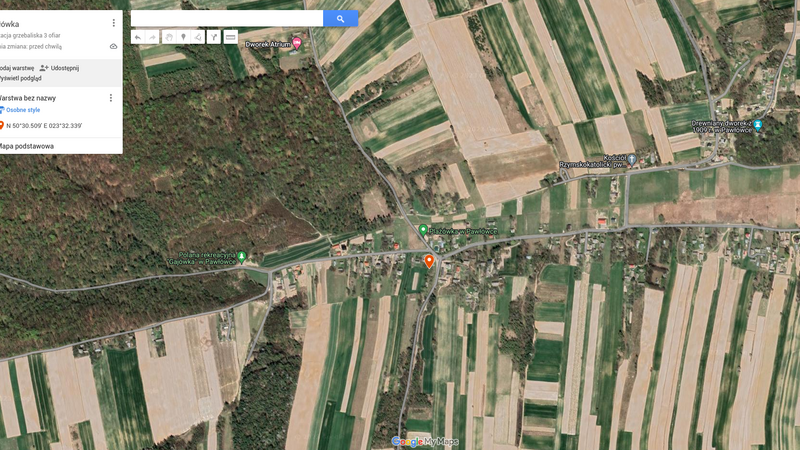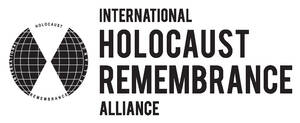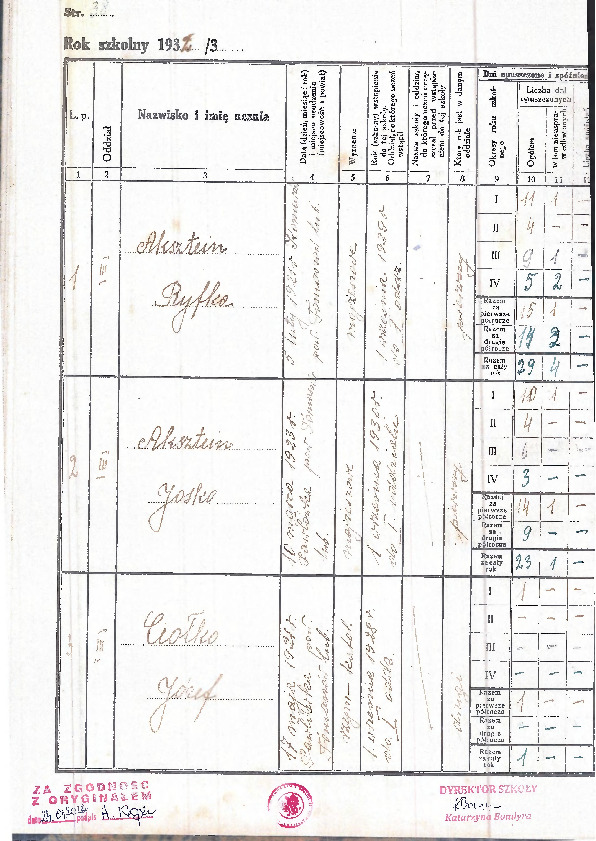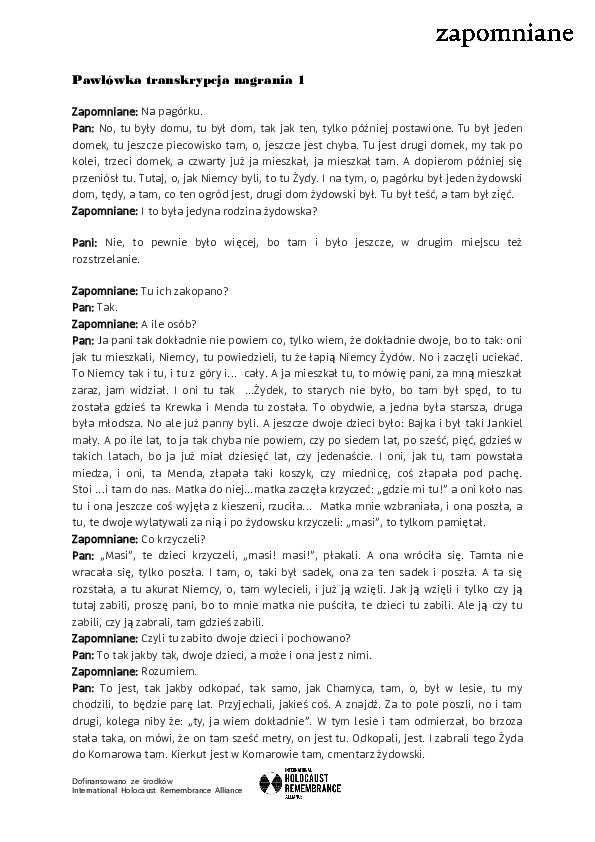Pawłówka
Borough of Rachanie, Tomaszowski District, Lubelskie VoivodshipType of place
Private plotInformation about the crime
We went to Pawłówka for the first time in the fall of 2021. We met residents who pointed out the approximate burial place of the three Jewish children Ryfka, Jankiel and Balka, probably murdered in 1943. We also met several times with Mr. Wladyslaw W., born in 1932, who witnessed the murder of the three siblings. Their mother was murdered during a public execution in Pawłówka in the summer of 1942. In Pawłówka, this event is referred to as an execution “under the figure”, “death” or “gathering”:
The folks [parents] weren’t there because there was a gathering. Ryfka and Mynda stayed here. One was older, and the other was younger. They were maidens already. There were also two children: Balka and little Jankiel. I don’t know how old they were, 7, maybe 6 or 5. I was 10 or 11 years old”. (Pawłówka, September 21, 2021)
When the Germans came to the village, the two older girls began to flee. Ryfka, hearing her younger siblings crying, turned back and was murdered with Jankiel and Balka. Mynda managed to escape. She is the only survivor of the family. After the war, she moved to the United States and lived under a changed name.
“These two [Jankiel and Balka] ran out and shouted in Jewish: ‘masi,’ that’s all I remember. They cried. And she [Ryfka] came back. The other one [Mynda] didn’t come back. She ran away. She went behind a nearby orchard and ran away. The other one [Ryfka] parted. The Germans just came here, and they took her [Rifka]. (Pawłówka, September 21, 2021)
Ryfka, Jankiel and Balka were murdered and buried near their family home. There were two other Jewish houses on the same street. According to stories told by residents of the Rachanie community, at least three Jewish families lived in Pawlowka before the war. The murdered children were members of the Aksztein family. Ruchla and Solko had six children named Ryfka, born February 5, 1921 in Komarów, Josko, born March 10, 1923 in Pawłówka, Fioma/Sioma, born June 30, 1925 in Pawłówka, Hylko, Jankiel and Balka. Ruchla’s sister lived in the village with her husband, Jankiel, and children, Lejzor, Chana, and Mynda. We were able to determine the fate of several of the people mentioned.
Ruchla Aksztein was probably killed on June 22, 1942, in a public execution of villagers, both Christians and Jews. Her husband Solko/Szolko and son Josko were killed in an execution in the manor in the fall of 1943. In total, five Jewish men were killed in the manor that day.
“In the fall of 1943, Germans from Rachanie came to Pawłówka. They surrounded the heir’s farm and found two Jews in the pigsty. The other Germans found three Jews in the orchard. One escaped. All five were shot in the woods. The servants from the manor were ordered to bury them at the place where they were shot”.
The cited survey states that in 1961, the bodies of the five men were moved to Bełżec (IPN Lu 501/70).
Ruchla’s son, Fioma/Sioma, died from infection after having his foot pierced with a nail; it is not known whether this occurred before or during the war. The fate of Hylko remains unknown. Ryfka (about 22 years old at the time of her death), and the youngest children Balka and Jankiel (about 5-6 years old) were killed near their family home and buried there. Ruchla’s sister and her daughter Chana died in the Bełżec death camp. Jankiel and Lejzor were murdered in an execution in Rachanie and rest there to this day in a mass grave.
Commemoration
On March 29 and 30, ceremonies were held in Tomaszów Lubelski and Pawłówka to commemorate the burial place of three Jewish children: Rywka, Bałka and Jankiel, murdered and buried near their home in Pawłówka during the Holocaust. It was one event spread over two consecutive days.
As part of the project “Reference points. Co-creation of wooden matzevot with the local community” co-financed by the Association of the Jewish Historical Institute, together with students of one grade of high school from Tomaszów Lubelski and one grade of primary school from Michałów, we prepared a wooden marker in the form of a matzevot and then used a portable We used a laser to burn an inscription and the names of the murdered children written on it by the hands of the workshop participants.
After the workshops, together with the youth, we went for a walk to the burial place of three children, where a commemoration ceremony took place and the burial site was marked with a wooden tombstone.
In addition to the youth, the ceremony was attended by representatives of local authorities, employees of the regional museum and the Museum-Memorial Site in Bełżec, residents of Pawłówka, teachers and the local choir.
The organization of the event was possible thanks to the support of the Association of the Jewish Historical Institute in Poland and the Szloma-Albam-Stiftung. The event was co-financed as part of the project “MultiMemo: Multidirectional Memory: Remembering for Social Justice”, implemented with the support of the European Union under the Citizens, Equality, Rights and Values (CERV) program.
IDENTIFICATION OF THE GRAVE BASED ON NON INVASIVE RESEARCH
On March 29, 2023, a site inspection was carried out at the location precisely indicated (GPS: N 50°30.509’E 023°32.339′) as the grave of 3 victims. The location is close to the main intersection of Pawłówka. The indicated area is located at the back of a no longer existing house, the remains of which are still visible today. The grave is located on a hill in the form of a terrace, a fragment of the grave is probably under the edge of a steep uplift visible in the photos of the location.
The indicated area was subjected to research using georadar (GPR). Three profiles were collected, named: PAW10001 – PAW10003, the echograms showed a disturbance of the soil layers in the place indicated as the grave location (red arrows) at approx. 1.90 – 3.90 m, presumed depth of approx. 0.80 – 1.0 m below ground level.
Landform measurement (LiDAR) is not helpful in this case.
No search was conducted for archival aerial photographs for this area.
 pawłówka fotografia satelitarna 1a
pawłówka fotografia satelitarna 1a pawłówka fotografia 1 lokalizacji
pawłówka fotografia 1 lokalizacji pawłówka echogramy PAW10001-PAW10003
pawłówka echogramy PAW10001-PAW10003Sources
Transkrypcje
Contact and cooperation
We are still looking for information on the identity of the victims and the location of Jewish graves in Pawłówka. If you know something more, write to us at the following address: fundacjazapomniane@gmail.com.
Bibliography
IPN Lu 501/70 Surveys of the The Regional Commission for the Examination of German Crimes in Lublin collected in 1968-1973 concerning the places and facts of German crimes on the territory of Tomaszów Lubelski district.
IPN Lu 504/15 Lists of people murdered during the German occupation from the territory of Tomaszów Lubelski district, drawn up by the Presidiums of the Municipal National Councils
School registers of the Primary School in Rachanie from 1932-1933
Recording of the Zapomniane Foundation (audio recording), Pawłówka village resident Władysław W. b. 1932, interviewed by Agnieszka Nieradko, Pawłówka, September 21, 2021.
Recording of the Zapomniane Foundation (audio recording), Pawłówka village resident Wladyslaw W. b., Pawłówka, September 21, 2021. 1932, interviewed by Agnieszka Nieradko, Pawłówka, March 29, 2023.
We have collected the materials about this village thanks to the funding provided by the International Holocaust Remembrance Alliance as part of the project “The rural Holocaust. Collecting and safeguarding the never recorded testimonies 100 forgotten Jewish graves 2021-2022”.


 Pawłówka Dzienniki szkolne Szkoły Podstawowej w Rachaniach z lat 1932-1933
Pawłówka Dzienniki szkolne Szkoły Podstawowej w Rachaniach z lat 1932-1933 Pawłówka transkrypcja 1
Pawłówka transkrypcja 1